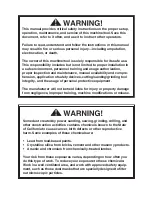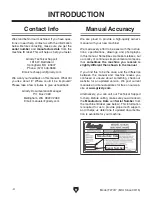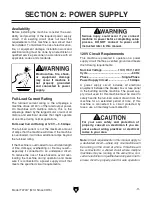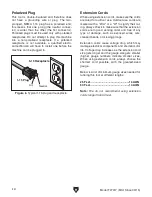
-10-
Model T27417 (Mfd. Since 09/15)
Additional Safety for Spindle/Edge Sanders
Serious injury or death can occur from fingers, clothing, jewelry or hair getting entangled
in rotating spindle or other moving components. Abrasion injuries can occur from touching
rotating sanding drum with bare skin. Workpieces thrown by drum can strike operator or
bystanders with moderate force, causing impact injuries. Long-term respiratory damage can
occur from using sander without proper use of a respirator. To reduce the risk of these hazards,
operator and bystanders MUST completely heed the hazards and warnings below.
AVOIDING ENTANGLEMENT. DO NOT wear
loose clothing, gloves, or jewelry, and tie back
long hair. Keep all guards in place and secure.
WORKPIECE INSPECTION. Nails, staples,
knots, or other imperfections in workpiece can
be dislodged and thrown from sander at high rate
of speed into operator or bystanders, or cause
damage to sanding sleeves, drum, or belts. Never
sand stock that has embedded foreign objects or
questionable imperfections.
TABLE INSERTS. A pinch point for fingers and
workpieces exists in the gap between table and
oscillating drum or belt. Always use table insert
that fits closest to diameter of installed drum to
keep this gap as small as possible and reduce
risk of injury.
POWER DISCONNECT. An accidental startup
while changing sleeves can result in entangle-
ment or abrasion injuries. Always disconnect
machine from power source before changing
sanding sleeve to avoid this risk.
WORKPIECE INTEGRITY. Sanding fragile
workpieces can result in loss of control, resulting
in entanglement, impact injuries, or damage to
the sanding sleeve, drum, or belt. Only sand solid
workpieces that can withstand power sanding
forces. Make sure shape of workpiece is properly
supported; avoid sanding workpieces without flat
bottom surfaces unless some type of jig is used to
maintain support and control when sanding force
is applied.
HAND PLACEMENT. Rotating sanding drums/
belts can remove a large amount of flesh in a few
seconds. Always keep hands away from drum/
belt during operation. Never touch moving drum
on purpose. Use a brush to clean table of sawdust
and chips.
FEEDING WORKPIECE. Forcefully jamming
workpiece into sanding surface could cause
workpiece to eject back at operator or damage
machine. Always allow spindle to reach full speed.
Firmly hold workpiece with both hands and ease it
against spindle using light pressure.
FEED DIRECTION. Feeding workpiece incor-
rectly can cause it to be thrown from machine,
allowing your hands to slip into the rotating drum
or striking yourself or bystanders. To reduce
these risks, feed workpiece against direction of
rotation, and never
sand tapered or pointed stock
with point facing feed direction.
SANDING SLEEVE/BELT CONDITION. Worn
or damaged sanding sleeves/belts can tear apart
and become entangled in spindle or other moving
parts, resulting in subsequent injuries from opera-
tor loss of workpiece control. Replace worn or
damaged sanding sleeves/belts promptly.
SANDING DUST. Sanding creates large amounts
of dust and flying chips that can lead to eye injury
or serious respiratory illness. Reduce your risk by
always wearing approved eye and respiratory pro-
tection when using sander. Never
operate without
adequate dust collection system in place and run-
ning. However, dust collection is not a substitute
for using a respirator.
Summary of Contents for T27417
Page 44: ......













































